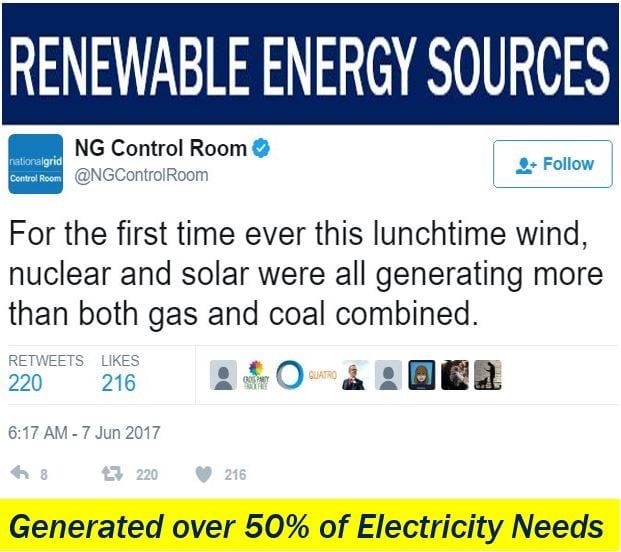Renewable energy sources generated more than half of the UK’s electricity for the first time ever at midday, on Wednesday, 7th June, 2017, Britain’s multinational electricity and gas utility company, National Grid plc, reported. Renewable energy is energy from a source that is not depleted when it is used, such as solar or wind power.
When we use coal or gas, we are depleting global coal or gas stocks. When we use sunlight or wind to produce electricity, we are not depleting global wind or sunlight stocks – as far as we are concerned, their supply is infinite.
National Grid tweeted on 7th June that for the first time ever, solar, wind, and nuclear energy all generated more electricity than both coal and gas combined.
According to data, wind farms and solar panels across the UK generated 9.5GW and 7.6GW of power respectively. The country burnt 2GW of **renewable biomass, and also generated a considerable amount of hydroelectricity.
** Renewable biomass is an energy source derived from organic matter such as garbage, crop waste and wood.

Renewable energy sources generated 19.3GW
Renewable energy generated 19.3GW, which was enough to meet more than fifty percent of Britain’s midday electricity demand of 35.4GW.
At midday, gas-fired power plants generated 20.8% of the country’s electricity requirement, compared to 23.2% from nuclear power.
In an interview with The Telegraph, Emma Pinchbeck head of RenewableUK, Britain’s leading not for profit renewable energy trade association, said:
“National Grid is confirming that low-carbon sources are generating 70pc of our electricity – with wind power the star amongst these sources.”
“Incoming government should be proud of what the wind sector has achieved in the UK, and work with the industry to ensure that these record-breaking days for wind energy generation become our new norm.”
The boom in power generated from renewable energy sources pushed market prices down into negative territory on Wednesday morning. National Grid was prompted to make payments to major energy consumers to use more power so that the grid was not overwhelmed by the greater supply.
List of common renewable energy sources
– Wind Power: capturing the energy in the movement of the air in our atmosphere (wind) to run wind turbines, which generate electricity.
– Hydropower: Using the energy from moving water, such as flowing rivers, dams, etc.. This category includes Tidal Power, converting the energy obtained from the tides in the sea, and Wave Power, using the waves in the sea created by wind.
– Solar Energy (Solar Power): harnessing radiant light and heat from the Sun.
– Geothermal Activity: using thermal energy generated and stored in the Earth.
– Bio Fuel (biomass): – using biological material derived from living or recently living organisms.
